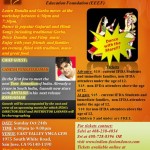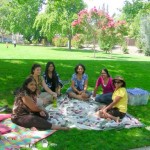Well, next in the calendar is Navratri, and Dandiya or Garba nights that come with it.
Garba is an Indian form of dance that originated in the Gujarat region. It is more similar to Western folk dance than to the presentational style of Indian classical dances such as bharatanatyam and odissi. The name garba comes from the Sanskrit term Garba (“womb”) and Deep (“a small earthenware lamp”).
Modern garba is also heavily influenced by raas. Raas or Dandiya Raas is the traditional folk dance form of Vrindavan, India, where it is performed depicting scenes of Holi, and lila of Krishna and Radha. Along with Garba, it is the featured dance of Navratri evenings in Western India.
There is a huge interest in Garba amongst the youth of the Indian and in particular Gujarati diaspora in Garba. Garba and Dandiya Raas are popular in US where more than 20 Universities have Raas Garba Competitions of a huge scale every year with professional choreography.
What to wear:
Both men and women usually wear colorful costumes while performing garba and dandiya. The girls and the women wear ghaghra choli, a three-piece dress with choli on the top and ghaghra as bottom, made of cotton with beads, shells, mirrors, sitars, and embroidery work, mati, jhumkas, necklaces, bindi, bajubandh, chudas and kangans, kamarbandh, payal, and mojiris and dupatta tucked in the Gujarati manner. Boys and men wear kafni pyjamas with a kediyu – a short round kurta – above the knees and pagadi on the head with bandhini dupatta, kada, and mojiris.
In Dandiya Raas men and women dance in two circles, with sticks in their hands. In the old times Raas did not involve much singing, just the beat of Dhol was enough. “Dandiya” or sticks, are about 18″ long. Each dancer holds two, although some times when they are short on Dandiya they will use just one in right hand. Generally, in a four beat rhythm, opposite sides hit the sticks at the same time, creating a nice sound. One circle goes clockwise and another counter clockwise. In US, people don’t form full circles, but instead often form rows.
Participate, and enjoy Dandiya in the Bay Area. For Tri Valley folks, there is one on Oct 16 in Pleasanton!
Vibha Dandia 2010
When: Saturdays, Oct 2nd, 9th and 16th
Where: Centerville Junior High School , 37720 Fremont Boulevard, Fremont, California 94538
Cost: Early bird tickets: $10, • Regular price: $13 • Kids aged 10 and under: FREE • Door price: $15 (if available)
Others: • Free Dandia/Raas/Garba lessons will be provided by experienced dancers to all ticket holders • Dandia sticks, Food and beverages can be purchased at the venue
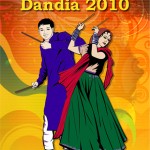
SEF Dandia 2010 Sankara Eye Foundation
When: Oct 9th and 23rd 2010 (Santa Clara) ; Oct 16th 2010 (Pleasanton) – 7:00 PM
Where: Santa Clara Convention Center, Alameda County Fairgrounds, Pleasanton
Cost: $15
Others: FREE: Dandia Lessons for ALL, Entrance For Kids Under Age 5, Parking. Also, complimentary Check-In Service for Your Dandia Sticks, Special Dancing Area For Kids providing them Extra Safety, Free teak dandia sticks for first 500 tickets per event
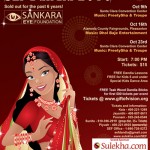
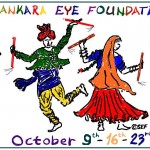
Small Steps Diwali Dandia 2010
When: Oct 30 2010, at 7:30pm
Where: Address :Centerville Junior High School in Fremont – 37720 Fremont Boulevard, Fremont, CA
Cost: Early Bird (Until Oct 10th) :Adult – $10, Child (5-12) – FREE, Regular (After Oct 10th) :Adult – $13, Child (5-12) – $5, At the Gate :Adult – $15, Child (5-12) – $5
Others: Free Dandia Lesson during 1st hour
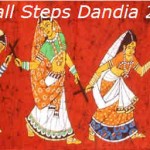
Sewa Dandia 2010
When: Oct 8 2010 8:00PM
Where: Sunnyvale Temple Hall, 420 Persian Drive, Sunnyvale, CA
Cost: General Admission $10 (FREE For Kids Under 10 Years)
Others: Subsidized food; All proceeds will go towards Sewa International service projects. Free lessons for Dandia.
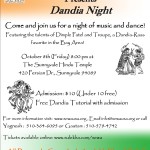
IFDA Navratri Hungama 2010
When: Oct 24 2010 6:00PM
Where: East Valley YMCA Gym, 1975 South White Road, San Jose, CA
Cost: :$10 Current IFDA Students and immediate families, non-IFDA attendes under the age of 12. $15 – non-IFDA attendees above the age of 12.
Others: Lessons; Celebrity Guest Ganesh Venkataraman; bone-marrow drive
